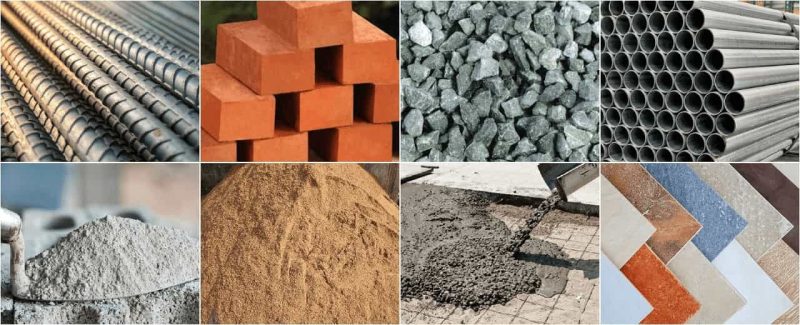
The construction sector’s journey began with the earliest human civilizations. From building pyramids and brick abodes to evolving into modern apartment complexes and towering skyscrapers. It is clear that building materials have been crucial from ancient times to the present day. Regardless of the time period, these materials are central to the successful management of construction projects of any kind. The need for building materials is enduring and is expected to persist indefinitely into the future.
The production of building materials has undergone considerable advancements in innovation and technology. Throughout this evolution, construction materials have been organized into categories based on specific trades such as plumbing, masonry, carpentry, roofing, grill works, insulation, and others, each further divided into more specialized areas. Here are some factors to consider when choosing building materials for your next construction project.
Cost
When scouting for materials for your project, you’ll notice significant price variations. Typically, the least expensive choices are not the wisest selections. It’s crucial to weigh the durability or longevity of these materials, a detail often overlooked by those seeking quick solutions. Choosing materials of lesser quality could necessitate regular repairs or replacements, incurring greater expenses over time than if one initially invests in superior brands.
Choosing products renowned for their enduring reliability is both a time and money saver. The investment in material costs plays a pivotal role as it secures the protection of your structure long after the project has been completed.
Durability
Certain construction materials have a higher longevity yet are more prone to damage from moisture, corrosion, and environmental and external factors. Choosing the right material based on the climate can ensure their durability. Consulting with professionals when selecting materials best suited to withstand the specific climate is also crucial.
Materials can break down quickly, particularly in moist environments. The construction materials must be strong and durable for the intended location and conditions. Choosing materials that require minimal upkeep and rare replacements is recommended, ensuring they last for the building’s entire lifespan and maximize the occupants’ benefit.
Aesthetic Appeal
Everyone’s preferences, requirements, and desires vary. Thus, what one person finds appealing might not captivate another. You are the best judge of the quality and type of home, construction, or building you wish to reside in. For example, choosing a specific type of flooring for your shed can significantly alter its appearance.
Your selection should reflect your personal taste and align with your financial plan, whether vitrified, granite, ceramic, Kota stone, marble, or wood. In making these choices, envision the look you are aiming for. With the help of the best shed builders, you can obtain the perfect blend of comfort and practicality that reflects your style.
Similarly, your preference for a particular type of roofing will influence the home’s overall feel. Whether you have a penchant for a certain roofing material or favor stone masonry constructions, your budget will shape your decisions, the local climate, and other considerations, ultimately determining the materials used and the resultant aesthetic of the building you envision.
Maintenance
The value of a property’s location is often overlooked during the selection of building materials, yet it should be the top consideration. This is because the location inevitably influences the architectural design and profoundly impacts the chosen materials’ resilience and lifespan.
For instance, for a property situated in an area with forests or mountains, avoiding wood-based materials like timber to avert pest problems and boost the structure’s damage resistance would be advisable.
In the same way, properties close to the sea should opt for materials that are not easily degraded by saltwater and moisture. The environment and location are instrumental from the beginning of the planning process, laying the essential base for all subsequent stages of construction.
Location
The prosperity of a project depends on the easy procurement of essential raw materials, equipment, and components. Suppliers must transport these supplies directly to the project’s location. Crucial aspects to consider include ensuring suppliers are reliable and can deliver the needed materials promptly and affordably, the simplicity of acquiring the necessary production materials, or any specific equipment required for manufacturing tasks.
Choosing to source materials from close proximity helps minimize both the economic and time expenditures linked to transport, thus keeping the project on its scheduled timeline. Carefully assessing these factors before progressing with a project can result in notable long-term reductions in both time and resources.

Material Availability
The success of a project relies on the accessibility of raw materials, equipment, and necessary components. Suppliers should deliver these resources to the project site. Key considerations should include the availability of dependable suppliers who can provide materials on time and at a reasonable cost, the ease of obtaining the required raw materials for production, or any specific machinery needed for manufacturing.
Opting for materials sourced from nearby reduces both the financial and temporal costs associated with transportation, allowing for adherence to the planned construction timeline. Evaluating these elements thoroughly before moving forward with a project can lead to significant savings in both time and resources over time.
Project Maintenance
A notable feature of marketed building materials is their reduced need for maintenance. A structure that is well cared for can appear as if it’s just been built even many years later. Materials of superior quality tend to require less frequent maintenance compared to their lower quality or more affordable counterparts.
Construction teams must evaluate the resilience and anticipated lifespan of the materials selected for use in a project, ensuring the finished building requires minimal upkeep.
Planning for a building’s structure significantly involves considering its maintenance needs. This includes pondering the building’s function during the construction stage and planning for its maintenance after completion. While the building phase may last only a few months to a few years, the period for maintaining the building stretches out for decades.
Recycling
The recyclability of materials at the end of their useful life is a crucial consideration in their selection process. For example, designers and developers should opt for bolted steel connections instead of welded ones. While bolted connections might demand more precision and effort, they are entirely recyclable. On the other hand, welded connections pose significant recycling challenges without emitting additional carbon into the environment.
Energy Efficiency
Selecting materials that enhance energy efficiency can significantly reduce the long-term operational costs of a building. Insulating materials, energy-efficient windows, and doors, as well as roofing materials with high reflective properties, can all contribute to lowering energy consumption. Using such materials not only helps in cutting down utility bills but also reduces the carbon footprint of the building, making it more environmentally sustainable.
Sustainability
The growing emphasis on sustainability in construction has led to the development of eco-friendly building materials. When selecting materials, consider those that are sustainably sourced, have a low environmental impact, and contribute to the overall sustainability of the project. Materials like bamboo, recycled steel, and reclaimed wood are excellent choices that offer durability while being environmentally friendly. Incorporating sustainable practices in material selection can also contribute to achieving green building certifications such as LEED.
Fire Resistance
Fire-resistant materials are essential for ensuring the safety and longevity of a building. Materials such as fire-rated gypsum board, concrete, and certain types of treated wood can help prevent the spread of fire and provide critical time for occupants to evacuate safely. Considering fire resistance in your material selection can significantly enhance the safety of your construction project and meet building code requirements.
Endnote
The construction industry continuously evolves, introducing many new technologies and materials every day. Consequently, choosing building materials that are most suitable for your project can be daunting. Follow the guidelines mentioned above to identify the optimal building materials for your future project.








